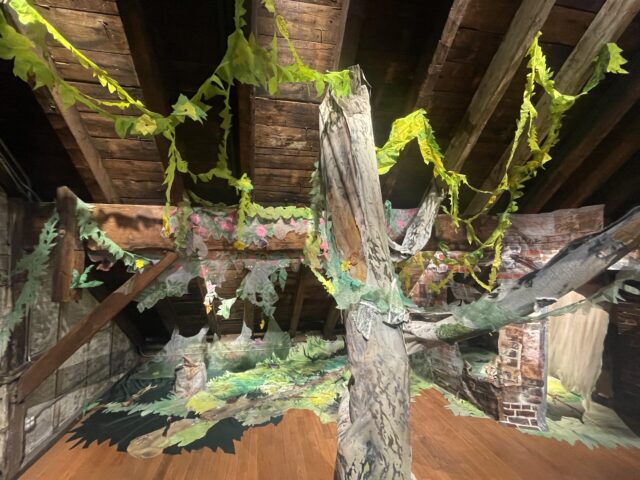
Sammy Bennett, A Little Beyond, Acrylic, screen-print, dye-sublimation, found objects, embroidery, foam, wire, cardboard, canvas, silk, 2025 (photo by twi-ny/mdr)
THE GOLDEN THREAD II: A FIBER ART EXHIBITION
BravinLee programs
207 Front St. between Fulton & Beekman Sts.
Through May 16, free, noon – 6:30
www.bravinlee.com
golden thread slideshow
BravinLee programs follows up last year’s “The Golden Thread” with a second iteration of the fabric installation, consisting of works by five dozen artists, highlighted by ten site-specific installations. Continuing through May 16, “The Golden Thread II” features colorful, often fragile pieces across five floors, a panoply of soft sculptures on the walls and floors and hanging from the ceiling.
Be sure to take each set of steps (including the spiral staircase) and go through every open door so you don’t miss a thing; be on the lookout especially for Felix Beaudry’s Put, an outstretched pink arm and hand; Sammy Bennett’s multipart camping-like installation (A little Beyond, Empty Lot, Mr. Grasshopper Meets a Shoe); Ruby Chishti’s An Intangible Sanctuary of Ocean and Stars II, a repurposed men’s wool overcoat; Ana Maria Hernando’s El intento del agua (“The Intent of Water”), a kind of endless blue wedding dress exuberantly pouring out of the bricks; Tomo Mori’s (we) keep going, a large loom using a metal pulley; Tura Oliveira’s Wheel of Fortune, an enormous red figure being tortured in a grain hoist evoking a Catherine wheel; Manju Shandler’s The Elephant in the Room, a big pachyderm huddling in a corner; Jacqueline Surdell’s Untitled [we can be stars], a cord, line, and steel construction resembling a giant fist coming toward the viewer; Halley Zien’s fabulously detailed fabric collages Morning Mourn and Family Sing; and Karen Margolis’s beautifully delicate Divagation, made from cotton-covered chicken wire, Acrylic, thread, rope, moss, paper, clay, eggshells, fishing line, nails, studio detritus wrapped in salvaged silk, organza, and grandmother’s unraveled bedspread. There are also contributions from Lesley Dill, Rashid Johnson, Valerie Hegarty, Sheila Pepe, Christopher Wool, Deborah Kass, Walter Robinson, and Jess Blaustein.
In her artist statement, Margolis explains, “I am drawn to discarded and damaged materials — remnants of past lives — which I collect, dismantle, and reconfigure into artificial nature sanctuaries. This process reflects my preoccupations with mending and regeneration. Rooted in wabi-sabi philosophy embracing imperfection and impermanence, my artmaking is directed at capturing the impact of destructive forces having worked their way through a material. These material transformations develop analogies between nature and psychological experience, blurring boundaries between solid form and the evanescence of emotions. Inspired by the micro-violence of spiders, my recent works explore themes of imprisonment and chrysalises.”
Bennett notes, “My work references quotidian settings pumped full of melodrama that give recognition to everyday life as a constant struggle. This large-scale installation transports you from the city to a damp forest in transition from winter to spring, where flowers are budding, insects are chirping, and an abandoned building serves as a reminder that everything we create will eventually be reclaimed by Mother Earth.”
And Oliveira points out, “A limp, humanoid figure is tangled in the spokes of an eighteenth-century grain hoist. Nerve endings crawl across the sculpture’s surface and the figure’s abdomen sags open in the shape of an unblinking eye, a wound from which sinewy tentacles spill, reaching outward like severed nerves or roots searching for ground. Titled after both the tarot card and the game show, in this work the grain hoist becomes the breaking wheel of public execution, history turns like a great wheel and catches us in its spokes.”
On May 16, Tiny Pricks Project author and activist Diana Weymar, whose American Sampler features hand-stitched vintage textiles and cotton floss with such sayings as “I ask you to have mercy,” “Nature gives us everything,” and “She said enough,” will be at the show from 3:00 to 6:00, signing copies of her new book, Crafting a Better World (Harvest, September 2024, $25). Weymar explains about her piece, “I work in the increasingly liminal space where textiles, text, and social media overlap. My work tracks current political discourse, pop culture, and cultural work from the past. Making text by hand is a sensory processing experience that provides a contrast to the speed with which we post language and communicate.”
[Mark Rifkin is a Brooklyn-born, Manhattan-based writer and editor; you can follow him on Substack here.]